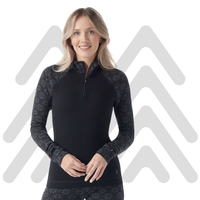How to dress for skiing
Skiing is an intense and exhilarating activity, but cold and wet conditions can quickly turn a beautiful day into a nightmare if you're not properly dressed. Proper skiing attire relies on the layering system, which helps regulate heat, manage moisture, and adapt to changing conditions. This article focuses on base and mid layers, which are essential for maintaining your comfort throughout the day.

1. Understanding the layer system: why is it important?
The layering system consists of wearing different types of clothing, each playing a specific role in managing body heat and moisture.
Base layer: Retains warmth by wicking moisture away from your body.
Mid layer: Provides additional thermal insulation.
Outer jackets and shells, which make up the outer layer, protect against wind and external moisture, but we will not cover them in this article.
2. Choose the perfect base layer to stay dry and warm
2.1 Types of Base Layers
Base Layer Material
Merino Wool:
Very warm, naturally resists odors, soft on the skin, but can be more expensive and less durable.
Synthetic (polyester, polypropylene):
Lightweight, quick-drying, and durable, but may retain odors and is less warm than wool.
Silk:
Lightweight and pleasant against the skin, but less effective at wicking moisture and more fragile.2.2 Which Thickness to Choose?
The thickness of the base layer (lightweight, midweight, or heavyweight) depends on the outside temperature and your activity level. In general:
Lightweight:
Perfect for mild conditions or for skiers who sweat a lot.
Midweight:
Provides balanced insulation in moderate conditions.
Heavyweight:
Ideal for very cold days and for less active skiers.
3. The mid-layer: the key to controlled warmth
The mid layer acts as an insulator. It traps body heat while allowing moisture to escape toward the outer layer.
3.1 Types of Mid LayersFleece: Lightweight, breathable, retains warmth even when damp, but less effective in windy conditions and not water-resistant.Down: Excellent warmth-to-weight ratio, highly compressible, but less effective in humid conditions and more expensive.Synthetic Insulation: Provides warmth even when wet, durable, but less compressible than down and slightly heavier.
3.2 Choosing the Thickness and Fit of the Mid Layer
The thickness and fit of the mid layer once again depend on the temperature conditions and the intensity of your activity:
Lightweight mid layers:
Recommended for moderate temperatures or as a complement to other thicker layers.
Heavy mid layers:
Ideal for freezing cold days.
4. Tips to optimize your comfort and performance
Here are some tips to maximize the effectiveness of your layering system and stay comfortable all day:
Avoid cotton:
This material retains moisture, which causes you to lose warmth.
Choose fitted cuts:
Clothing that is too loose can let cold air in.
Consider multi-layer garments:
This allows you to adjust your clothing depending on the weather or the intensity of the activity.
Conclusion
Your base and mid layers are essential for your comfort on the slopes. Choosing the right materials and thicknesses will ensure you have a pleasant day skiing, no matter the conditions. Feel free to explore our website to discover our full range of ski clothing adapted to each layer and find the best fit for your style and the conditions you encounter.
-Shop Team
